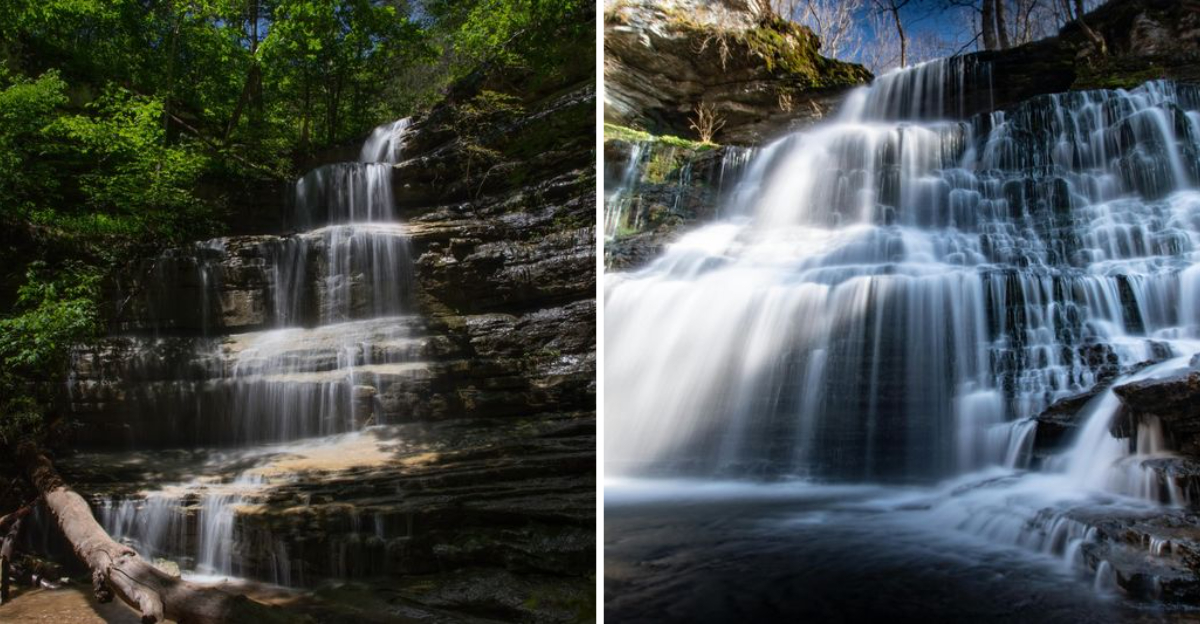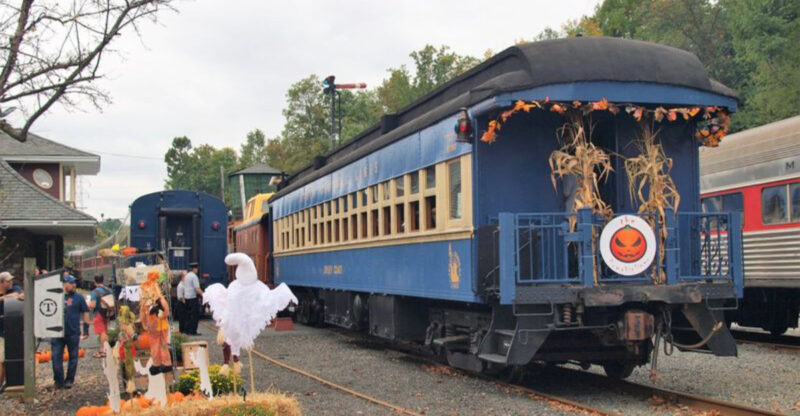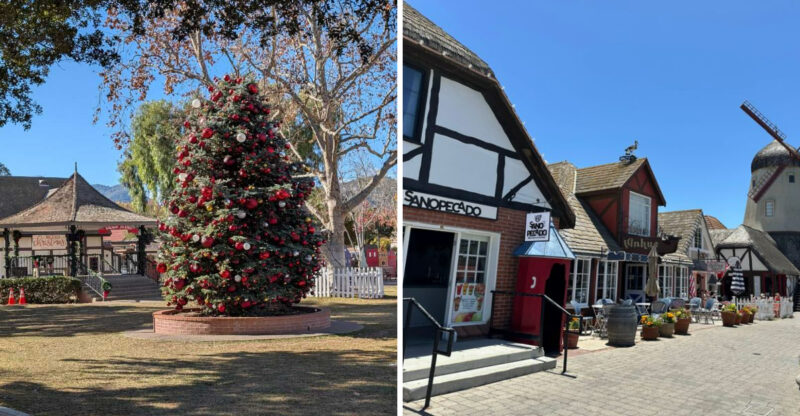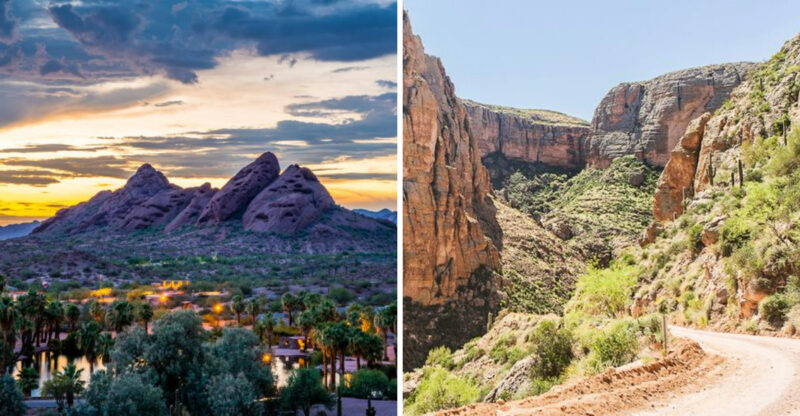12 Scenic Waterfalls In Tennessee Tucked Away From The Crowds

Tennessee’s rolling hills and lush forests hide some of nature’s most spectacular water features.
While popular spots like Fall Creek Falls draw thousands of visitors, the state harbors dozens of lesser-known cascades perfect for peaceful adventures.
I’ve explored these hidden gems for years and compiled this list of secluded waterfalls where you can enjoy nature’s symphony without fighting through crowds.
1. Cummins Falls: Nature’s Hidden Swimming Hole
Nestled within the Cummins Falls State Park sits one of Tennessee’s best-kept secrets. The 75-foot cascading waterfall creates a pristine natural swimming basin at its base, surrounded by limestone walls that give it a secluded, almost private feel.
Most tourists flock to more accessible falls, leaving this gem relatively quiet, especially on weekdays. You’ll need to hike about a mile and a half through moderate terrain to reach it, which naturally filters out the crowds.
During summer months, the cool, crystal-clear pool becomes a refreshing reward after your trek. Remember to bring water shoes with good grip the rocks can be slippery, and the journey involves crossing shallow streams.
2. Greeter Falls: The Three-Tiered Wonder
Hidden within South Cumberland State Park, Greeter Falls offers not just one but three distinct waterfall experiences. The Upper, Middle, and Lower falls each have their own personality, with the Lower being the most dramatic at 50 feet tall.
What makes this spot special is the spiral staircase descent that adds a touch of adventure to your journey. Few people venture beyond the upper section, meaning you’ll often have the lower falls to yourself if you’re willing to make the full trek.
During spring, wildflowers dot the trail leading to these cascades. I’ve visited dozens of times and still find the blue-green pool at the base mesmerizing, especially when afternoon light creates rainbow mists through the falling water.
3. Twin Falls: The Dam-Created Miracle
Unlike most waterfalls that flow down from mountains, Twin Falls emerges horizontally from the rock face! This unusual phenomenon happened when the Collins River was dammed to create Great Falls Lake, causing water to find escape routes through underground caves.
The result is a pair of side-by-side waterfalls that seem to burst from the cliff wall. You’ll find it at Rock Island State Park, but despite being in a state park, it remains less visited than others because it’s tucked away from main tourist routes.
When water levels are high after rain, the falls become thunderous and dramatic. The viewing area sits close enough to feel the mist but far enough to capture perfect photos without getting your camera wet.
4. Ozone Falls: The Movie-Famous Cascade
If Ozone Falls looks familiar, you might recognize it from scenes in the original Jungle Book movie! Despite this claim to fame, this 110-foot plunge waterfall remains wonderfully uncrowded thanks to its location off the beaten path in Cumberland County.
The short quarter-mile trail leads to an impressive overlook, but adventurous hikers can carefully make their way to the base where a massive rock overhang creates a natural amphitheater. Water crashes into a deep, circular pool that reflects sunlight in mesmerizing patterns.
Fall visits reward you with fiery red and orange foliage framing the white cascade. The waterfall’s flow varies dramatically with rainfall after storms it becomes a thundering curtain, while during dry spells it transforms into delicate bridal-veil threads.
5. Piney Falls: The Double-Feature Forest Gem
Deep within the Piney Falls State Natural Area lies a two-for-one waterfall adventure that few tourists discover. Upper and Lower Piney Falls are connected by a half-mile trail through old-growth forest that feels like stepping back in time.
Lower Piney drops 40 feet into a rock-enclosed pool, while Upper Piney cascades 80 feet through a narrow gorge. The surrounding virgin timber includes massive hemlocks and white pines estimated to be over 300 years old.
Mossy rocks and fern-covered banks create a prehistoric atmosphere along the connecting trail. I recommend visiting after light rain when the falls flow vigorously but the trail isn’t too muddy and bring binoculars as the area is known for its diverse bird population including scarlet tanagers and pileated woodpeckers.
6. Foster Falls: The Rock Climber’s Paradise
Though Foster Falls appears in some guidebooks, its location within South Cumberland State Park keeps it less crowded than you’d expect for a 60-foot waterfall. The observation deck provides spectacular views, but the moderately difficult trail to the base rewards adventurous hikers with an immersive experience.
Rock climbers know this spot for its world-class routes on the surrounding sandstone cliffs, which ironically helps keep the waterfall area less congested. The plunge pool’s emerald waters contrast beautifully with the reddish-brown cliff faces.
Winter visits offer a rare treat when ice formations create natural sculptures around the falls. The nearby campground makes this an ideal overnight destination, and if you arrive early morning or near sunset, you might have this magnificent cascade entirely to yourself.
7. Stinging Fork Falls: The Butterfly-Shaped Beauty
Named for the creek that creates it, Stinging Fork Falls tumbles 30 feet into a serene pool within the Stinging Fork Pocket Wilderness. What makes this waterfall special is its unusual butterfly shape, created by water flowing over a rock ledge that splits the cascade into symmetric wings.
The 1.5-mile round-trip hike keeps casual tourists away, ensuring peaceful visits even on weekends. Giant boulders scattered around the base create perfect natural seating areas for contemplating the falls’ beauty.
Spring brings a bonus the surrounding gorge explodes with wildflowers including trillium, bloodroot and wild geranium. I’ve spent hours here sketching the falls from different angles, each perspective revealing new details in how water interacts with the ancient rock formations.
8. Benton Falls: The Family-Friendly Secret
Tucked away in the Cherokee National Forest, Benton Falls remains surprisingly uncrowded despite being accessible via a relatively easy 1.5-mile trail. The 65-foot waterfall cascades over a wide rock shelf, creating a curtain effect that’s particularly impressive after rainfall.
Families appreciate the well-maintained trail and the large flat rocks at the base that make perfect picnic spots. Unlike many hidden falls that require challenging hikes, this one delivers significant scenic payoff for moderate effort.
Autumn transforms the surrounding forest into a kaleidoscope of colors, making it my favorite season to visit. The small lake near the trailhead, Lake Chilhowee, offers additional recreation opportunities if you want to make a full day of your adventure – from fishing to swimming during warmer months.
9. Margarette Falls: The Moss-Covered Masterpiece
Few visitors to the Great Smoky Mountains region discover Margarette Falls, hidden in the Cherokee National Forest near Greeneville. The 60-foot waterfall tumbles down a stair-stepped rock face covered in vibrant green moss, creating a striking visual contrast with the white water.
A moderate 2.7-mile round-trip hike follows Dry Creek (ironically named, as it’s rarely dry) through a boulder-strewn gorge. Multiple small cascades along the way serve as appetizers before the main attraction.
Photography enthusiasts will love how the waterfall splits into multiple channels as it descends, creating excellent opportunities for long-exposure shots. The best time to visit is weekday mornings in late spring when wildflowers carpet the forest floor and the crowds are virtually non-existent.
10. Rutledge Falls: The Historic Swimming Hole
Unlike most waterfalls on this list, Rutledge Falls flows through private property that the generous owners have opened to the public. This historical site near Tullahoma has been a local swimming hole for generations, yet remains unknown to most tourists.
The short walk from the parking area makes it accessible, but limited publicity keeps crowds manageable. The 40-foot waterfall cascades over limestone ledges into a crystal-clear pool that’s perfect for swimming during hot Tennessee summers.
Massive beech trees provide shade around the falls, their smooth gray trunks carved with dates going back decades a living record of visitors past. I recommend bringing water shoes for exploring the creek bed above and below the falls, where smaller cascades and natural water slides await discovery.
11. Liles Falls: The Photographer’s Dream
Hidden deep within the Big South Fork National River and Recreation Area, Liles Falls rewards adventurous hikers with one of Tennessee’s most photogenic cascades. The multi-tiered 30-foot waterfall slides gracefully over smooth sandstone, creating patterns that change with every water level.
Getting here requires navigating unmarked trails and creek crossings, which naturally limits visitors to determined waterfall enthusiasts. During rainy seasons, multiple side streams create additional mini-falls that feed into the main cascade.
Morning visits often reveal magical light beams piercing through the forest canopy to illuminate the mist rising from the falls. I’ve found this spot particularly magical during winter when parts of the falls freeze into ice sculptures while water continues flowing through other sections creating a dynamic display of water in all its forms.
12. Machine Falls: The Geological Wonder
Machine Falls might have an industrial name, but there’s nothing manufactured about its natural beauty. Located in the Short Springs Natural Area near Tullahoma, this 60-foot cascade flows over unique geological formations that create a stair-step effect.
The moderate 1.6-mile loop trail sees fewer visitors than you’d expect for such a spectacular sight. What makes this waterfall special is how it splits into multiple channels around large boulders before reuniting in a plunge pool below.
Ferns and mosses thrive in the constantly moist microclimate created by the falls, giving the entire gorge a primeval feeling. Spring visits bring the added bonus of wildflower displays, including rare species that botanists travel miles to document. The natural area’s limited parking naturally restricts visitor numbers, making this a perfect escape even on summer weekends.






